My favorite genre of gaming growing up was fantasy-based platformers. The likes of Super Mario 64 and Crash Bandicoot appealed to me. I loved point A to point B games where you had to take on a villain on at the end or follow a linear plot. To me, they were like super-long films but in interactive form. Not to mention, I preferred films with fantasy settings, mainly animated ones. Games like that were my thing.
Like many 90s kids, I grew up with the great PlayStation trilogy that was Insomniac’s Spyro the Dragon. A great blend of fantasy, action-adventure and some comedy; it was a great example of what a family-friendly adventure game should be. Its gameplay is dotted with puzzles and challenges, while also trying to mix other things in. Sometimes successfully, sometimes not so successfully...
As a kid, I always favored the first game while still loving its sequels: Spyro 2: Ripto’s Rage (known as Spyro 2: Gateway to Glimmer in Europe) and Spyro: Year of the Dragon. Something about the first game really struck a chord with me; I think it was the overall atmosphere and the music... The sequels are very different in those two departments, and looking back on it, it’s for the better. Crash Bandicoot, the sort of “older brother series”, was no different. The first game differs significantly from its sequel, and that sequel is pretty different from the third one.
Spyro the Dragon’s plot is pretty simple: An evil villain named Gnasty Gnorc used to be a threat to the Dragon Kingdom, but now he’s isolated on a remote island. After a dragon mentions that he is ugly, he uses his club-like scepter to trap them all in a crystal. He misses Spyro, which means that the young dragon must free all of his older brethren. It does raise a few questions... Why is Spyro the only young dragon? Why are all the dragons male? Why are the dragons being interviewed by what seem to be people? Is this serious? Or is this some kind of irreverent game that gladly breaks the fourth wall? Was it just the developers poking fun at the game itself similar to the outtakes on some of the earlier Pixar films? Who knows; that shtick was cut for the sequels though.
Gnasty also turns all of the treasure of the Dragon World into minions, mostly the “gnorcs”, which are really humanoid troll-like things. There isn’t much depth to the story, Gnasty is the stock evil villain with not much background. Spyro doesn’t have much of a personality either, aside from the occasional sarcasm and whininess. He’s a little upstart that’s too interested in toasting Gnasty Gnorc, instead of focusing on what lies ahead on his long journey through the different realms of the dragon’s world. He doesn’t seem to show much development, it also doesn’t help that there aren’t many cutscenes. Whenever Spyro frees a dragon, there will be a brief conversation, but it’s either hints, jokes or a rather redundant “Thank you for releasing me!”
Yes, the game’s story is very minimal. It’s way too basic, and I’m fairly certain that Insomniac realized this. As result, they tried harder with the story and characters in the next two games. So if the story isn’t all that great, what is so good about this game?
Well the gameplay is very solid, the graphics were marvelous for their time... But best of all, it’s a very pretty game to look at. All of the different worlds have a distinct look and feel, but what I like about the design is that it perfectly captures a sort of fairy tale-esque atmosphere. From floating castles to colorful rooms built into hills and mountains, it’s just great to look at. Even today. A lot of imagination was breathed into the game. It’s just a bit of a shame that the story is so non-existent, this could’ve had a very compelling story.
However, it’s hard to pick at the game because of this since it is the first installment in the trilogy. After all, the first Crash Bandicoot game’s story is minimal, it’s very point A to point B. The two sequels don’t have much of a story either, since the titular character is a mute and the rarely seen sister speaks or has a prominent role.
 |
| The Artisan home world. |
The game takes place in six different worlds that have at least four individual levels and a boss level. The first world is the Artisan World, which is essentially bright green grass and pretty castles. Even a level like Dark Hollow is lighthearted, it’s all kinds of nice. Stone Hill and Sunny Flight stick with the theme, but Town Square goes for an old world Spain atmosphere with its cobblestone paths, enemy bulls and gnorc bullfighters. Then you get to Toasty, the stage that’s the home of the titular boss. It looks like a hellish version of the Artisan Home, with its darker red/orange color scheme.
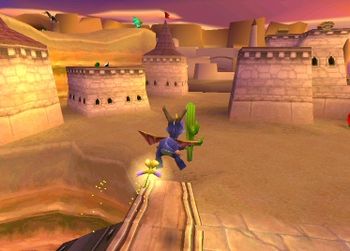 |
| Cliff Town. |
The second world is much tougher, the Peace Keepers World. It’s very militaristic, and it’s mostly deserts, save for the cold and barren Icy Cavern. In the home level, gnorcs carry weapons, only to run from you. They use canons, and you can use them too. Dry Canyon and Cliff Town repeat this theme, Night Flight is far removed from the theme. The boss here is Doctor Shemp, whose level is not desert-like but more like a combination between a canyon and grasslands.
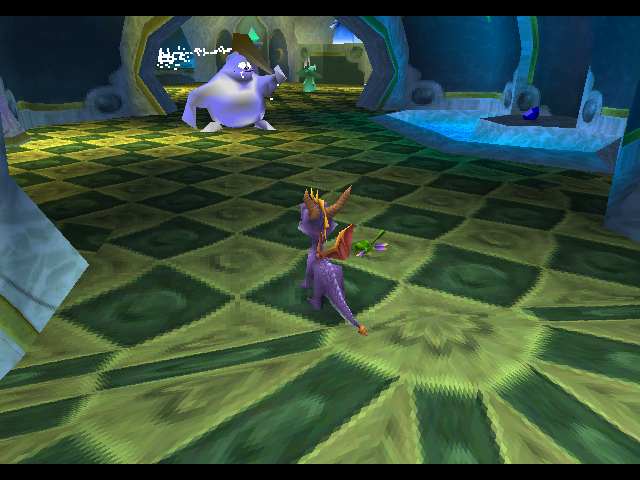 |
| Wizard Peak. |
The Magic Crafter’s World, the third world, is closer in style to the Artisan Home with its lighthearted aura and heavy focus on... You guessed it, magic. Witchcraft, druids making things move, villainous wizards. All that good stuff. Lots of nice-looking castles and architecture define this world, but unlike the Artisan World, there are lots and lots of heights. Alpine Ridge and High Cliffs take the cake here.
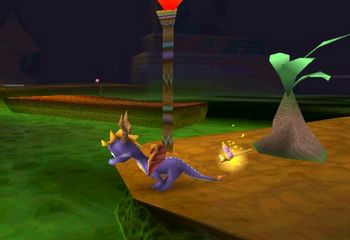 |
| Beast Makers home world. |
My favorite of the worlds is the fourth one, the Beast Makers world. A very mucky, muted swamp-like world that’s far removed from the whimsical nature of the Artisan and Magic Crafter’s Worlds, the Beast Makers world is the darkest of the worlds. Some levels here have ominous low-key music and a rather creepy atmosphere, while most are loaded with bizarre enemies.
 |
| Lofty Castle. |
The fifth world is the Dream Weaver’s World, which is once again similar to the Artisan and Magic Crafters worlds, but with unpredictable enemies and lots of new challenges. Design-wise, it isn’t too different from a lot of the previous levels we go through up until this point. Like its name implies, it's suitably dreamy and mostly airy. Look no further than Lofty Castle and Haunted Towers.
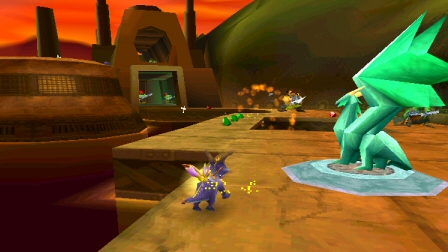 |
| Twilight Harbor. |
Gnasty’s World is the final world. Called the “Gnorc Gnexus” in the game, it’s ugly, metallic and cold. Gnorcs use explosives and machine guns instead of regular weapons. These guys mean business now that you’re in the final stretch.
To wrap it up, the design is great and it still looks wonderful to this day. So, the gameplay...
Spyro is no different from platformers of the time: You collect things and finish open-ended levels. Spyro’s objective is to free the dragons that have been trapped in crystal and to collect all the treasure. Treasure can be found scattered around, many times in chests, boxes of explosives (flame them and stand clear!), strange fan-like propeller pods, or enemies. You also have to collect stolen dragon eggs, which are in the possession of pesky thieves dressed in blue that don’t attack you; you just have to chase them down. To move onto the next home world, you have to have a certain amount of treasure or you have to have freed a certain amount of dragons in order to be granted permission to pass. In every home world, a balloonist lets you go from world to world when you have met his requirements...
 |
| What's wrong with your eye there, Spyro? |
By the way, what are the balloonists? Are they humans? Or some humanoid kind of thing? What else exists in this world besides dragons? Well you see fairies here and there, and you’ve got your protector dragonfly Sparx. His color indicates your health, and the more you get hit, the weaker he gets. Sparx collects the gems, but when he’s blue or green rather than gold, he doesn’t get the gems until you move closer to the treasure. You’re in trouble when you’re without him. How do you get him back? Fodder!
Every level has little creatures like sheep, hopping mushrooms, chickens, frogs, and rats... All kinds of small things that are harmless. Take them down and you’ll get butterflies, which Sparx eats to get stronger. You are always reminded of this thanks to certain dragons that you free, as they remind you of other little things in case you forget anything.
You have some moves, of course. When you were a kid in the 90s, chances are you were excited to see what you could do with a dragon as opposed to Mario, Sonic and Crash Bandicoot. You can charge your enemies with your horns, or toast them with your fire breathing. Some enemies can’t be charged, while others can’t be toasted (mostly due to armor or something). You can also glide to other areas, but you can’t fly except in the Flight levels. Each world, save for Gnasty’s World, has one. In these levels, you have to complete timed challenges by flying through things and flaming objects. For instance, in the Night Flight level, you fly through swirling rings, arches and then you flame treasure chests and lighthouses. Just watch out for the water.
That’s right, you can’t swim in this game. The sequels allow you to swim, so Spyro the Dragon is essentially the Grand Theft Auto III/Grand Theft Auto: Vice City of the original trilogy, and you are a bit limited here since many worlds are loaded with water or some kind of killer liquid that function like bottomless pits.
The Flight levels are simply the low point of the game; not because they are bad, but because they don’t really add much. Being able to fly does sound like fun, but since it’s only used for timed tasks, it’s a letdown. How come other levels couldn't have brief challenges where you had to fly in order to get something? Why did the developers opt for the same thing for each flight level instead of a different challenge where you didn't have to fly through things or flame objects?
Every level has little creatures like sheep, hopping mushrooms, chickens, frogs, and rats... All kinds of small things that are harmless. Take them down and you’ll get butterflies, which Sparx eats to get stronger. You are always reminded of this thanks to certain dragons that you free, as they remind you of other little things in case you forget anything.
You have some moves, of course. When you were a kid in the 90s, chances are you were excited to see what you could do with a dragon as opposed to Mario, Sonic and Crash Bandicoot. You can charge your enemies with your horns, or toast them with your fire breathing. Some enemies can’t be charged, while others can’t be toasted (mostly due to armor or something). You can also glide to other areas, but you can’t fly except in the Flight levels. Each world, save for Gnasty’s World, has one. In these levels, you have to complete timed challenges by flying through things and flaming objects. For instance, in the Night Flight level, you fly through swirling rings, arches and then you flame treasure chests and lighthouses. Just watch out for the water.
That’s right, you can’t swim in this game. The sequels allow you to swim, so Spyro the Dragon is essentially the Grand Theft Auto III/Grand Theft Auto: Vice City of the original trilogy, and you are a bit limited here since many worlds are loaded with water or some kind of killer liquid that function like bottomless pits.
The Flight levels are simply the low point of the game; not because they are bad, but because they don’t really add much. Being able to fly does sound like fun, but since it’s only used for timed tasks, it’s a letdown. How come other levels couldn't have brief challenges where you had to fly in order to get something? Why did the developers opt for the same thing for each flight level instead of a different challenge where you didn't have to fly through things or flame objects?
 |
| Supercharge. |
Aside from all the basic gameplay, what else can you do? There are power ups like supercharge and superflame. In order to do a supercharge, you have to find a path with arrows that light up. That way, you run so fast that your feet move like wheels; points for the chugging noise when you do so. Superflame is given to you (in certain levels, of course) by red fairies when they give you a kiss, and then your flame can take out anything. It’s very useful in levels like High Caves and Haunted Towers where there’s enemies that you can’t charge or flame.
You have a nice variety of abilities, but not too much. It’s a decent amount for a platformer, especially for the first game, but there could be a bit more. Luckily the sequels expanded upon this, much like how Crash Bandicoot’s sequels tried new things.
But with a limited amount of things to do, why does this game work so well? Collecting treasure is satisfying, I mean, what’s better looking than multi-colored gems? Seriously, I loved collecting them. When you hit the jackpot, it’s also a lot of fun. It gives you that satisfied feeling, but then all that fun is gone once you’ve already gotten the gems. When you defeat enemies that you’ve defeated before, you get clear orbs. Collect enough and you’ll get another life. Lives are normally hidden in clamshells, and there are a good amount of them.
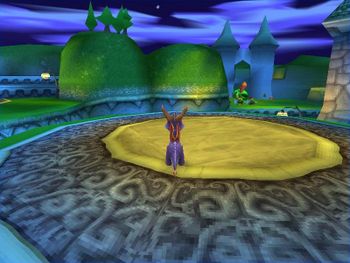 |
| Dark Hollow. |
Each level’s layout is fun to try out, and each has a set of challenges. For example, one level might have an area that you can only reach when you use the supercharge. Others have enemies that change, such as Dark Passage, where the darkness turns the small enemies into bigger ones. Dark Passage, along with some other levels, contain hidden areas that are fun to find and explore. Sometimes you’ll come across tricky heights, and at other times you’ll have to find way to destroy an armored treasure chest. It provides enough challenge for a game that’s this short.
If you want to simply be like Spyro and quickly get to the end of the game more than anything, you'll have to backtrack and collect gems that you have missed or free dragons that haven't been released. After you defeat Gnasty Gnorc, you need to have 100% completion in order to access the final level - Gnasty's Loot. However, I just collect everything before advancing to the next world; that way you can get to the loot after defeating the dastardly villain.
The only other problem with this game’s gameplay is that it’s a little too easy. The levels usually follow the same formula without mini-games, you simply free dragons, collect treasure and retrieve stolen dragon eggs. That can get a bit monotonous once you starting getting towards the end of the game. Boss battles aren’t much to write home about either. The boss battles are essential levels with a big enemy at the end. The only one I’d call a bit challenging is Metalhead. The rest are way too easy. Doctor Shemp is essentially a bigger and stupider Papu Papu from Crash Bandicoot, though his frantic running after you flame him is hilarious. Toasty? Flame him three times and you’re good. Blowhard? More of the same; just avoid his rather pitiful attacks. Jacques? Just chase him without falling and getting hit by his boxes. Gnasty Gnorc? Again, chase him and flame him. There’s not much of a challenge, here.
If there’s one more thing to praise, it’s the soundtrack. Stewart Copeland, the drummer from The Police, provided the music for the whole trilogy. Spyro the Dragon’s music is a mix of pure fantasy and rock music elements. The two styles mix perfectly. Each level has a great track; whether it’s the soaring, magical tone of the Dream Weaver’s levels to the murky and spooky vibe of the Beast Maker’s levels. Copeland often mixes rock guitars into the songs, without having them seem out of place. Other levels even hint at jazz and world music... It’s just the perfect mix, and if you ask me, this game boasts the best soundtrack out of the whole trilogy.
That’s not to say the other two games have highly inferior soundtracks, but this one is very special. It nails the setting completely, even if the story and gameplay may not add up in the long run. I could probably dedicate a whole blog post to this soundtrack, but to be to blunt – it’s just all-around wonderful. It’s all kinds of good, and each track just works so well its respective level.
I used to favor this game over the two sequels mostly because of the design and the music. They certainly are the game’s strongest points and they really make the game stand out, but looking back on it, a much stronger story would’ve gone perfectly with these visuals. The game has a sort of lonely feel because of the minimal dialogue. There’s not much else in this world outside of the dragons... The fairies don’t speak to you, and when your enemies have been defeated, all you have left is the fodder creatures. Nothing lives inside of the smaller buildings and castles that the dragons obviously can’t fit into, there’s no sense of... Community. Unless Gnasty has a lot of innocent beings locked up, we don’t see anything else besides dragons. Also, the dragons simply disappear after you have freed them.
That brings up another question. Why do the dragons disappear after you free them? They can’t help Spyro because that would be too easy. However, when you get to Gnasty’s World, you’ll free some dragons that you’ve already released. Did they attempt to stop him only for Gnasty to crystallize them again? How come Gnasty didn’t freeze Spyro? Did he simply miss him or does he want to mess with him? I know I might be dissecting what is essentially a harmless family-friendly game, but the sequels seemed a lot more logical when it came to this kind of thing.
I may seem a bit harsh on this game, but I actually love it. Despite its flaws, I can’t resist it. Easy as it is, I still enjoy playing the whole game from start to finish. It’s a fun experience, and it may not provide too much of a challenge, but these worlds are great to explore and the music is a treat. Some of the more challenging parts of the game are certainly fun to try, such as using supercharge on levels like Tree Tops and Haunted Towers; or finding hidden areas in other levels.
This also may sound a bit crazy, but I’d love to see Insomniac revisit the first game and remake it with a bigger story, more interactions with different characters and perhaps bosses that are far more challenging. Maybe they can also expand the levels and make them bigger, but still keeping the overall design and feel. Oh, and keep the original music and try to stay true to the feel of the original. I'd actually like to see that happen one day.
Spyro the Dragon was a fabulous game for its time and it’s still good fun today. If its gameplay and story don’t hold up too well in some areas, then it’s the great look and sound of it that does. It’s a true PlayStation classic.
In part two, I’ll look at its sequel - Spyro 2: Ripto’s Rage!
The only other problem with this game’s gameplay is that it’s a little too easy. The levels usually follow the same formula without mini-games, you simply free dragons, collect treasure and retrieve stolen dragon eggs. That can get a bit monotonous once you starting getting towards the end of the game. Boss battles aren’t much to write home about either. The boss battles are essential levels with a big enemy at the end. The only one I’d call a bit challenging is Metalhead. The rest are way too easy. Doctor Shemp is essentially a bigger and stupider Papu Papu from Crash Bandicoot, though his frantic running after you flame him is hilarious. Toasty? Flame him three times and you’re good. Blowhard? More of the same; just avoid his rather pitiful attacks. Jacques? Just chase him without falling and getting hit by his boxes. Gnasty Gnorc? Again, chase him and flame him. There’s not much of a challenge, here.
If there’s one more thing to praise, it’s the soundtrack. Stewart Copeland, the drummer from The Police, provided the music for the whole trilogy. Spyro the Dragon’s music is a mix of pure fantasy and rock music elements. The two styles mix perfectly. Each level has a great track; whether it’s the soaring, magical tone of the Dream Weaver’s levels to the murky and spooky vibe of the Beast Maker’s levels. Copeland often mixes rock guitars into the songs, without having them seem out of place. Other levels even hint at jazz and world music... It’s just the perfect mix, and if you ask me, this game boasts the best soundtrack out of the whole trilogy.
That’s not to say the other two games have highly inferior soundtracks, but this one is very special. It nails the setting completely, even if the story and gameplay may not add up in the long run. I could probably dedicate a whole blog post to this soundtrack, but to be to blunt – it’s just all-around wonderful. It’s all kinds of good, and each track just works so well its respective level.
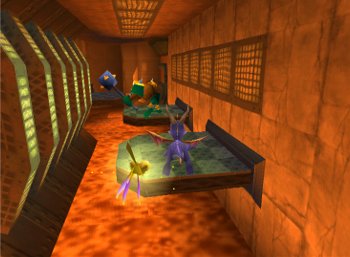 |
| Going after Gnasty Gnorc. |
I used to favor this game over the two sequels mostly because of the design and the music. They certainly are the game’s strongest points and they really make the game stand out, but looking back on it, a much stronger story would’ve gone perfectly with these visuals. The game has a sort of lonely feel because of the minimal dialogue. There’s not much else in this world outside of the dragons... The fairies don’t speak to you, and when your enemies have been defeated, all you have left is the fodder creatures. Nothing lives inside of the smaller buildings and castles that the dragons obviously can’t fit into, there’s no sense of... Community. Unless Gnasty has a lot of innocent beings locked up, we don’t see anything else besides dragons. Also, the dragons simply disappear after you have freed them.
That brings up another question. Why do the dragons disappear after you free them? They can’t help Spyro because that would be too easy. However, when you get to Gnasty’s World, you’ll free some dragons that you’ve already released. Did they attempt to stop him only for Gnasty to crystallize them again? How come Gnasty didn’t freeze Spyro? Did he simply miss him or does he want to mess with him? I know I might be dissecting what is essentially a harmless family-friendly game, but the sequels seemed a lot more logical when it came to this kind of thing.
I may seem a bit harsh on this game, but I actually love it. Despite its flaws, I can’t resist it. Easy as it is, I still enjoy playing the whole game from start to finish. It’s a fun experience, and it may not provide too much of a challenge, but these worlds are great to explore and the music is a treat. Some of the more challenging parts of the game are certainly fun to try, such as using supercharge on levels like Tree Tops and Haunted Towers; or finding hidden areas in other levels.
This also may sound a bit crazy, but I’d love to see Insomniac revisit the first game and remake it with a bigger story, more interactions with different characters and perhaps bosses that are far more challenging. Maybe they can also expand the levels and make them bigger, but still keeping the overall design and feel. Oh, and keep the original music and try to stay true to the feel of the original. I'd actually like to see that happen one day.
~
Spyro the Dragon was a fabulous game for its time and it’s still good fun today. If its gameplay and story don’t hold up too well in some areas, then it’s the great look and sound of it that does. It’s a true PlayStation classic.
In part two, I’ll look at its sequel - Spyro 2: Ripto’s Rage!
All gameplay images are courtesy of the uploaders on the Spyro Wiki!
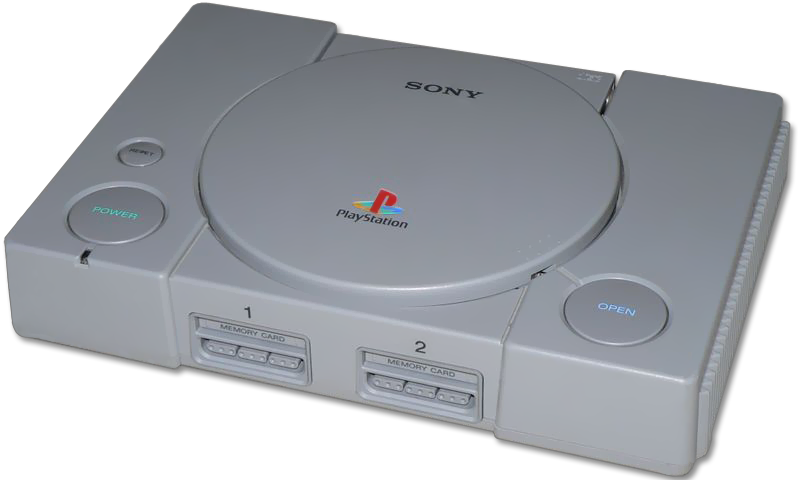
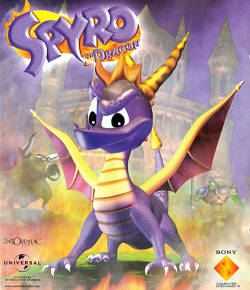

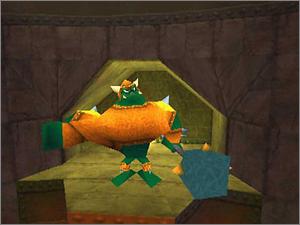
No comments:
Post a Comment